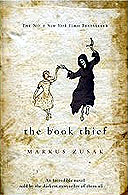
Bibliography
Zusak, Markus. 2005. THE BOOK THIEF. Alfred A. Knopf. ISBN0375831002
Plot Summary
Hovering over Nazi Germany in 1939, Death needs a distraction from his stressful job. He finds one in nine-year-old Leisel Meminger, a young girl living with her foster family in Molching. Fascinated by her strength and bravery in these difficult times, Death is especially puzzled to find that she steals books rather than food in order to survive. Haunted by her humanity and her love of words, he feels compelled to share her story.
Critical Analysis
With a world-weary and often sarcastic tone, Death narrates the story of little Leisel Meminger as she travels to Molching, Germany to live with a new family. The year is 1939 and Hitler’s Nazi party has begun its reign of terror on the Jews. Young and illiterate, Leisel is starving not only for food, but for love, companionship, and knowledge. She finds all of these with Hans and Rosa Huberman. Hans is the gentle, loving, parent who changes the sheets when Leisel wets the bed, plays the accordion to make her smile, and even indulges her with a glass of champagne. Rosa on the other hand, is not tender. Her criticisms are sharp as are the swats from her wooden spoon, but underneath it all, her love runs deep.
The only thing that Leisel has arrived with is a stolen copy of The Grave Digger’s Handbook which becomes a catalyst for late night reading lessons with her new papa. These special moments console Leisel at a time when her life has been turned upside down. As a result, words (and thus books) become more important to her than food and soon she is stealing them whenever the opportunity presents itself – first from the bonfire on Hitler’s birthday and then later from the Mayor’s wife’s library. Along the way, Leisel forges memorable friendships with Rudy Steiner, the “lemon-haired” boy who always says, “How about a kiss Saumensch?” and Max, a Jew that the Hubermans hide in the basement. Through her relationship with Max and by witnessing Jews being marched to the Dachau concentration camp, Leisel sees for herself the power of words to destroy lives. The plot escalates as the horrors of the war finally reach Leisel’s neighborhood. Fathers such as Hans and Alex Steiner are forced to join the war, sons are lost in battle, and air raids become more frequent.
Although Death has warned readers early on that the ending is tragic, it is very difficult to put this book down. The vivid images and beautifully crafted text make the people and the places come alive causing readers to hope against hope that everyone who has become dear to them will survive. This mesmerizing and emotional tale of friendship, love, and the power of words will stay with readers long after the last page has been turned.
Review Excerpts/Awards
Starred Review from Kirkus Reviews: (Ages 12+) The writing is elegant, philosophical and moving. Even at its length, it’s a work to read slowly and savor. Beautiful and important. Starred Review from Horn Book: "Exquisitely written and memorably populated, Zusak's poignant tribute to words, survival, and their curiously inevitable entwinement is a tour de force to be not just read by inhabited."
Connections - History
1) Appreciating different cultures: To help students connect to the WWII era in which the story takes place, have them research both the German and Jewish cultures (food, music, traditions, clothing, etc...). Set aside time at the beginning of class to allow short presentations in which they can share information or items such as pictures, music clips, and food samples.
2) Follow a timeline of the events of the Holocaust at: http://www.historyplace.com/worldwar2/holocaust/timeline.html
This is a great site because users can click on a specific year. Students might be interested in following the years from the novel (1939-1942) to find out about other significant events that took place during the time in which the story was set.
3) For a wealth of information on topics related to the Holocaust, visit the United States Holocaust Memorial Museum Website: http://www.ushmm.org/
There is a LOT to look at, but I was particularly drawn to this link entitled "Rescuing the Evidence." There are many personal experiences to read about: http://www.ushmm.org/research/collections/curatorscorner/
If you check out this link entitled "Accidental Witnesses to History: The Baker Collection," you'll see rare video footage that shows how extravagantly the Germans decorated their buildings to honor Hitler. The video also shows Jewish storefronts that have been defaced by the Nazis. http://www.ushmm.org/research/collections/curatorscorner/detail.php?content=2011-03-01
This is a great site because users can click on a specific year. Students might be interested in following the years from the novel (1939-1942) to find out about other significant events that took place during the time in which the story was set.
3) For a wealth of information on topics related to the Holocaust, visit the United States Holocaust Memorial Museum Website: http://www.ushmm.org/
There is a LOT to look at, but I was particularly drawn to this link entitled "Rescuing the Evidence." There are many personal experiences to read about: http://www.ushmm.org/research/collections/curatorscorner/
If you check out this link entitled "Accidental Witnesses to History: The Baker Collection," you'll see rare video footage that shows how extravagantly the Germans decorated their buildings to honor Hitler. The video also shows Jewish storefronts that have been defaced by the Nazis. http://www.ushmm.org/research/collections/curatorscorner/detail.php?content=2011-03-01
No comments:
Post a Comment